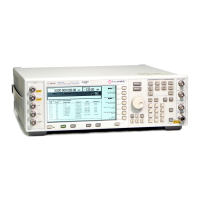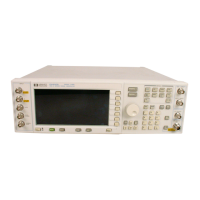35
www.agilent.com/find/esg
Receiver measurements
The Bluetooth RF test specification outlines several test scenarios under which receiver
performance must be verified. These tests are intended to ensure that receivers in all
Bluetooth devices meet a minimum performance criterion. A general overview of the
Bluetooth receiver test cases can be found in Application Note 1333-1: Bluetooth RF
Measurement Fundamentals.
ESG BER analysis capability
When performing Bluetooth receiver measurements, bit-error-rate (BER) is used as a
gauge to verify compliant operation. This section describes the ESG vector signal
generator’s BER analysis capabilities.
Figure 39. ESG configuration required to perform Bluetooth BER analysis.
The ESG internal BER analyzer is capable of analyzing framed and unframed continuous
PN9, PN11, PN15, PN20, and PN23 baseband data sequences only. Performing BER
analysis on unframed data requires two signals (data and clock) while framed data
requires three signals (data, clock, and gate). The clock signal is used to indicate the
bit rate of the incoming data sequence to the BER analyzer. The gate signal is used to
enable the BER analyzer only when the continuous PN9 or PN15 baseband data portion
of a frame is present for analysis. When performing Bluetooth BER measurements, the
gate signal is used to recover the continuous PN9 payload data portion of a Bluetooth
packet sequence. Figure 39 indicates the required ESG configuration to perform BER
analysis on Bluetooth signals generated by Signal Studio.
Basic Measurements
E4438C ESG vector signal generator
• Option 503 250 kHz to 3 GHz frequency range
• Option 602 Baseband generator with 64 MSa
• Option 406 Signal Studio for Bluetooth
• Option UN7 Internal BER analyzer
RF test signal
LAN or GPIB

